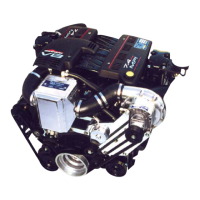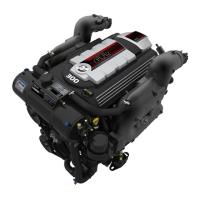Testing for a Cylinder Head Gasket Leak
A leaking head gasket will cause combustion gas to be forced into the cooling system. The mixture of coolant and tiny air
bubbles is a poor heat conductor and will overheat an engine quickly. Compression tests or cooling system pressure check
normally will not detect the leak because the test pressure is far below the combustion pressures that cause the leak. An
effective test is as follows:
IMPORTANT: Operate the boat in the water for this test. It is best to operate the engine at or above cruising speed during this
test. Usually a failed head gasket will not cause the engine to overheat below cruising speed.
1. Install a clear plastic hose between the reservoir and the coolant recovery bottle. Use a 91 cm (3 ft) long hose for this test.
2. Route this hose so that a "U" is formed.
3. Put enough coolant into the hose to fill the center 127 mm (5 in.) of the U‑shape.
4. Observe the U‑shape while the engine is operating.
•
During idle and warm‑up: Some coolant and air will leave the reservoir.
•
At cruising speed (2500‑3500 RPM): Coolant and air leaving the reservoir should stop after approximately five
minutes operating at a given RPM. A leaking head gasket will produce air bubbling through the U‑shape, going to the
coolant recovery bottle. The frequency and size of the bubbles will depend on the size of the leak.
•
At higher speeds (4000+ RPM): Normal operation is the same as described above. A failed head gasket will cause
the bubbles to come faster and may be accompanied by violent, intermittent bursts of coolant.
Do not confuse normal warm‑up expansion with a failed head gasket. Normal warm‑up produces an intermittent flow of coolant
that will stop within approximately five minutes at a given RPM. A head gasket leak will not stop; the one thing that marks a
failed head gasket is the continued passage of air. This may be accompanied by violent, intermittent bursts of coolant leaving
the reservoir. If coolant flows evenly from the reservoir at cruising speed, something other than the head gasket is causing the
engine to overheat.
Thermostat
Thermostat Removal
Refer to the exploded view.
1. Drain the coolant from the engine.
2. Disconnect the hose from the thermostat housing cover.
3. Remove the thermostat housing cover bolts, the cover, and the seal.
4. Remove the thermostat from the thermostat housing.
Thermostat Testing
1. Remove the thermostat.
2. Place the thermostat on blocks in a container.
3. Add water to the container until it covers the thermostat.
4. Heat the water.
5. Stir the water constantly to avoid applying direct heat to the thermostat.
a - Wooden blocks
b - Stirring rod
c - Thermometer
d - Thermostat
6. Observe the thermostat and check the temperature when the thermostat fully opens. If the temperature is not within
specifications, then replace the thermostat.
Models with Closed Cooling
Page 6C-14 © 2016 Mercury Marine 90-8M0099748 eng DECEMBER 2015
